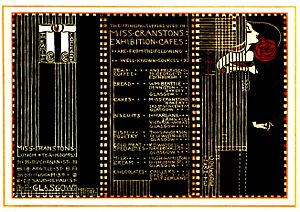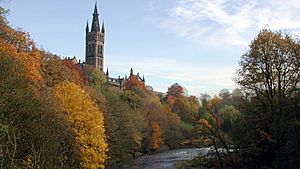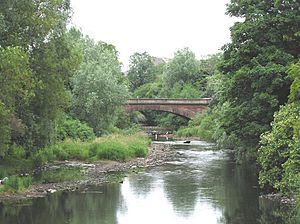Scottish Exhibition of National History, Art and Industry facts for kids
The Scottish Exhibition of National History, Art and Industry was a big event held in Glasgow, Scotland, in 1911. It was like a huge fair or festival that showed off the best of Scotland's history, art, and industries. This exhibition was the third of four major international shows held in Glasgow around that time.
Contents
What Was the Exhibition About?
The 1911 exhibition took place in Kelvingrove Park, just like two similar events before it in 1888 and 1901. It opened on May 2nd and closed on November 4th, 1911. Over 9.3 million people visited the exhibition during that time!
The main goal of the exhibition was to raise money. This money was used to create a new teaching position at the University of Glasgow. This new role was for a professor who would teach about Scottish history and literature. The people who planned the exhibition believed it was very important to teach Scottish history in a new and better way.
What Could You See and Do?
The exhibition was set up near the River Kelvin. It had many different buildings and areas to explore.
Main Buildings and Displays
- Palaces of History: One building looked like Falkland Palace, showing off Scotland's past.
- Palaces of Industries: Here, visitors could see new inventions and products made in Scotland.
- Palaces of Art: This area displayed beautiful artworks.
- Concert Hall: A place for music and performances.
- Aviation Building: This building showed off the latest in flying machines.
- Decorative Art: Displays of beautiful crafts and designs.
The exhibition grounds were located a bit further east than the 1901 event. The famous Kelvingrove Art Gallery and Museum was not part of the exhibition site this time.
Fun and Entertainment
Visitors could enjoy many fun activities:
- Boat Trips: Rides on the river.
- Aerial Railway: A ride that took people high above the grounds.
- Highland Village: A special area designed to look like a traditional Scottish Highland village. You can still see a stone cairn (a pile of stones) today that marks where this village once stood.
People on Display
Besides the Scottish Highlanders in the Highland Village, the exhibition also featured people from other parts of the world. There were groups from Lapland and West Africa. The West African group included about 100 people, including children. They came from places like Equatorial Africa, the French Congo, Dahomey, and Sudan.
These groups performed religious ceremonies, sang, and danced. Many visitors enjoyed these performances. However, some people at the time felt that showing people in this way was not right and lowered the quality of the exhibition. Today, we understand that displaying people from different cultures as "exhibits" is disrespectful and wrong. It reflects outdated and harmful ideas about race and colonialism that are not acceptable.
What Lasted After the Exhibition?
The land where the exhibition was held is still Kelvingrove Park today. It remains a popular park in Glasgow.
The exhibition was very successful in its main goal. The money raised helped create the new teaching position for Scottish History and Literature at the University of Glasgow. This happened in 1913, and the first professor to hold this important role was Robert Rait.
See also
- International Exhibition of Science, Art and Industry (1888)
- Glasgow International Exhibition (1901)
- Empire Exhibition, Scotland 1938
- Glasgow Garden Festival (1988)




